Table of Contents
Humans cause climate change. How do we know?
Scientists agree that global warming is caused mainly by human activity. Specifically, the evidence shows that certain heat-trapping gases, such as carbon dioxide, are warming the world—and that we release those gases when we burn fossil fuels like coal, oil, and gas.
As scientific models and methods grow more sophisticated, and as we collect more data, our confidence in human-caused climate change only grows higher. Here’s what we know.
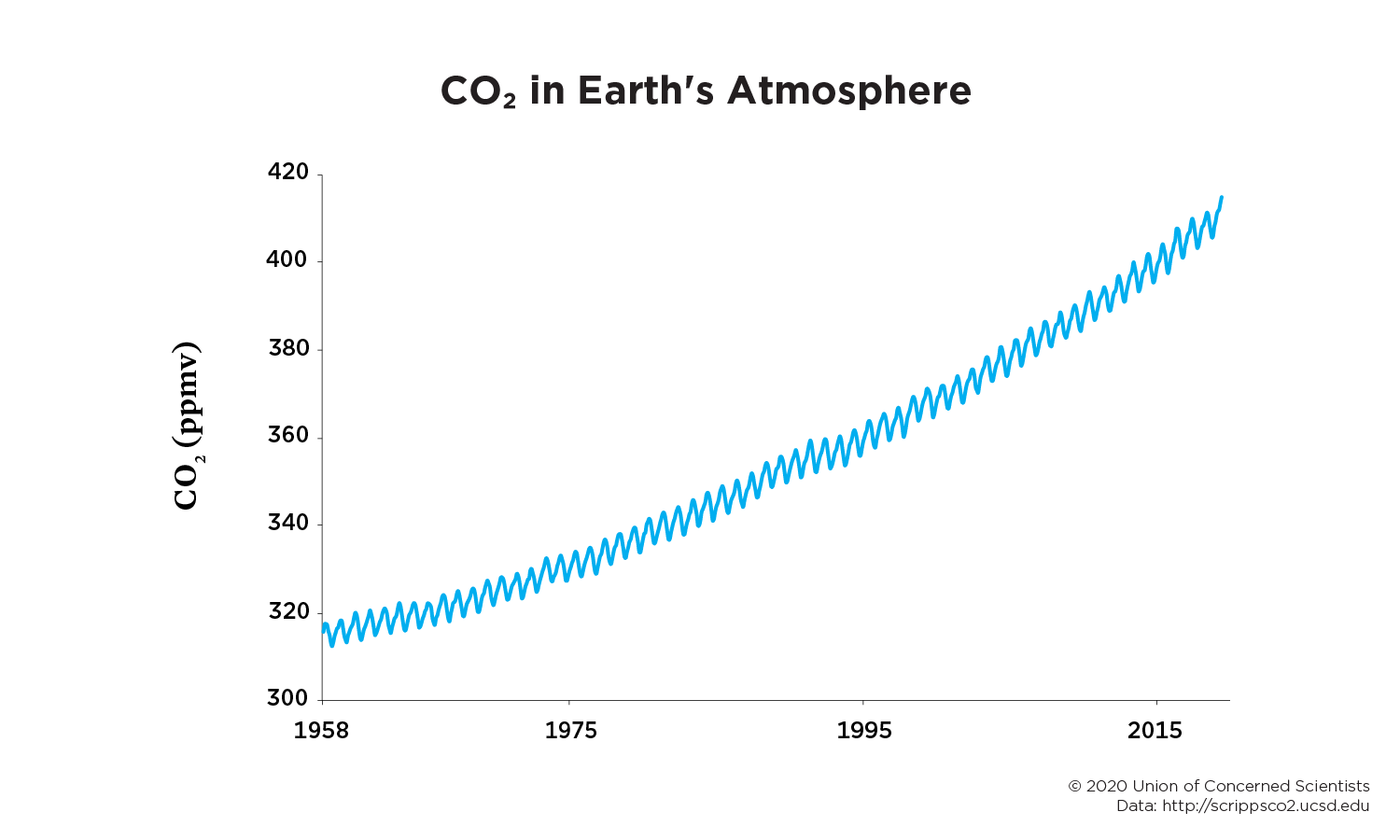
Climate science 101
Climate science encompasses a range of disciplines, from oceanography and meteorology, to chemistry, physics, biology and computer science.
Generally speaking, scientists working on climate change compare the climate patterns they observe with patterns developed using sophisticated models of Earth's systems (such as the atmosphere and ocean). By comparing the observed and modeled patterns, scientists can positively identify "human fingerprints” and attribute a proportion of observed warming to human activities.
These fingerprints are found in a diverse range of records from the atmosphere, the ocean, and Earth’s surface. They include rising levels of carbon dioxide, unprecedented warming, and a distinct atomic signature left behind in the atmosphere when fossil fuels are burned.
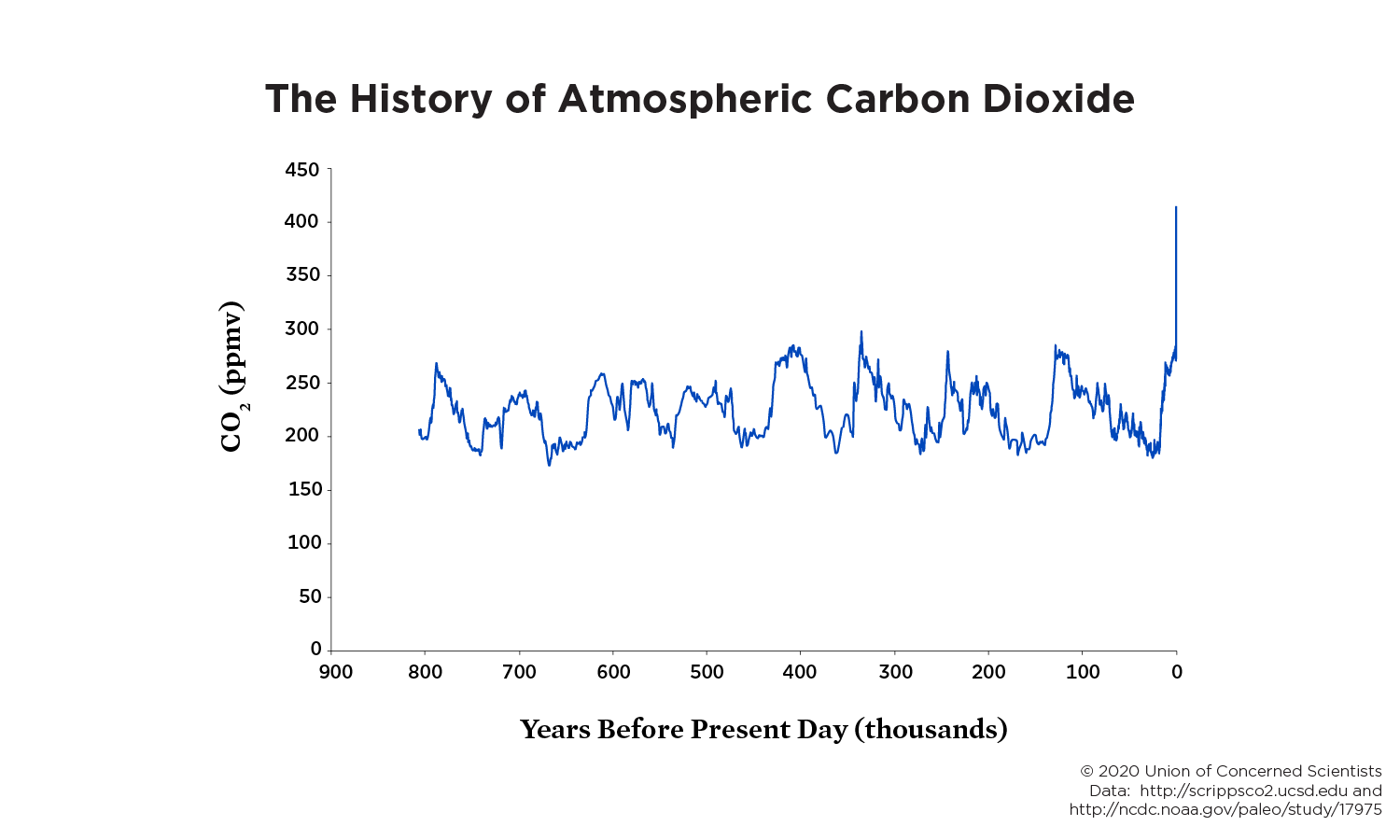
Rising carbon dioxide levels
Carbon dioxide (CO2) is the heat-trapping gas in our atmosphere responsible for most of the warming measured over the past several decades. It’s released during cement manufacturing and when coal, gas, and oil are burned—something humans started doing a great deal of during the Industrial Revolution through to today.
The concentration of CO2 in the Earth’s atmosphere has increased dramatically over the last 150 years, from a pre-industrial era concentration of approximately 280 parts per million (ppm) to more than 410 ppm currently. CO2 concentration levels are unlikely to dip below these annual averages for hundreds of years.
In fact, measurements from ancient ice cores show that CO2 is now at its highest levels in over 800,000 years.
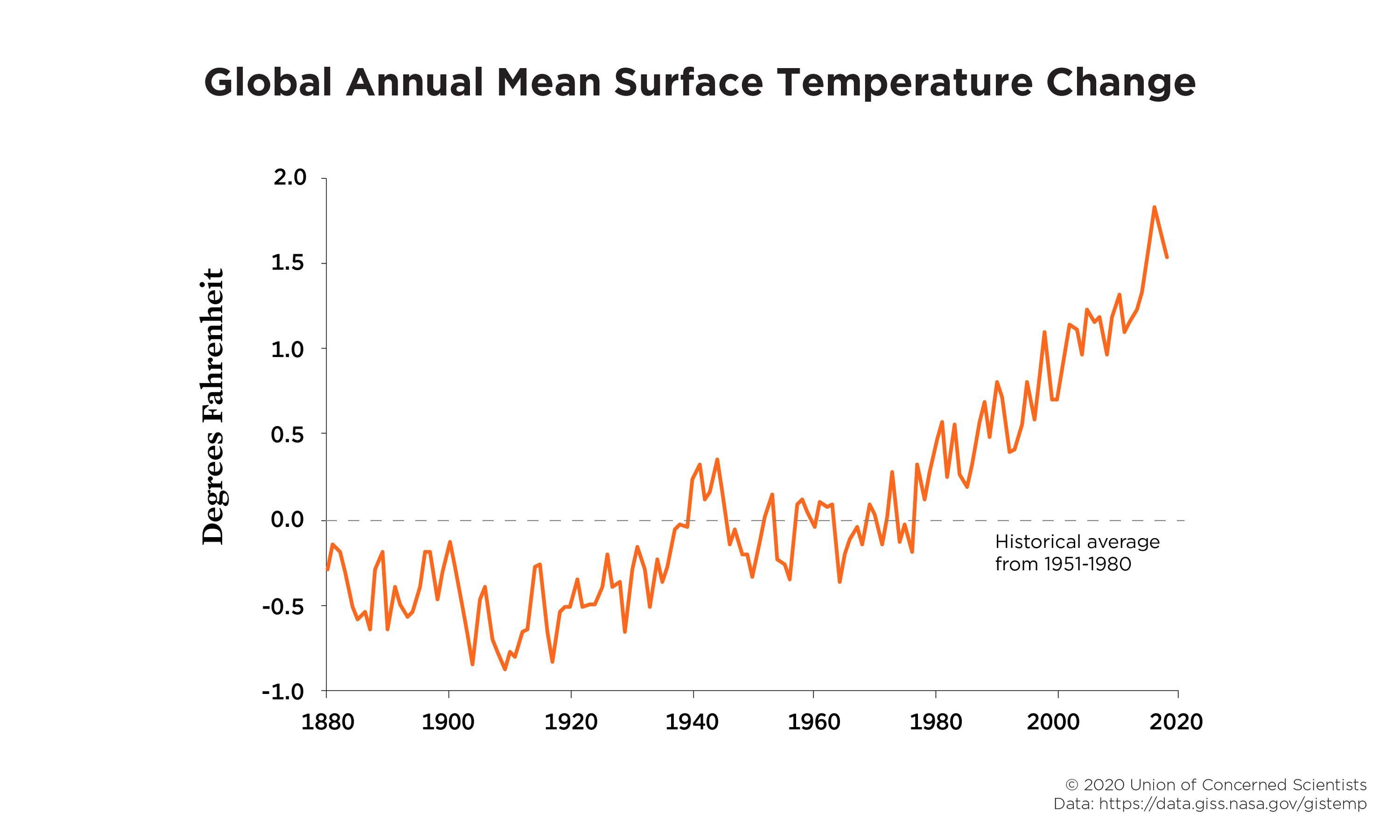
Unprecedented warming
As the concentration of CO2 and other heat-trapping gases in the atmosphere rises, the Earth warms up. In fact, Earth has recently undergone unprecedented warming, particularly since the 1950s.
Every single year since 1977 has been warmer than the 20th century average. Nineteen of the 20 warmest years have occurred since 2001. The period of 2015 to 2019 included the top five hottest years on record.
Analysis of these trends strongly suggests that without the emissions from burning coal and oil, it is very unlikely that 13 out of the 15 warmest years on record would have occurred either on their own or in such quick succession. This also makes sense from the known causes.
It is extremely likely that human activities, especially emissions of greenhouse gases, are the dominant cause of the observed warming since the mid-20th century.
Fossil fuel fingerprinting
We know that CO2 warms the world, that CO2 concentrations are at record-breaking levels, and that global temperatures are rising. But how do we know for certain that humans are the cause?
The answer is in the science. The CO2 produced from fossil fuels carries a unique signature that differentiates it from CO2 produced from other sources. In brief, it carries a specific ratio of carbon isotopes that is only found in the atmosphere when coal, oil, or gas is burned.
Scientists call this δ13C (pronounced "delta C thirteen"), and it’s a smoking gun. Since the 1880s, δ13C has changed in a way that could only happen if CO2 was increasingly coming from fossil fuel sources.
This information tells scientists that human-caused fossil fuel emissions have been the main contributor to the rise in CO2 concentrations since the pre-industrial era.
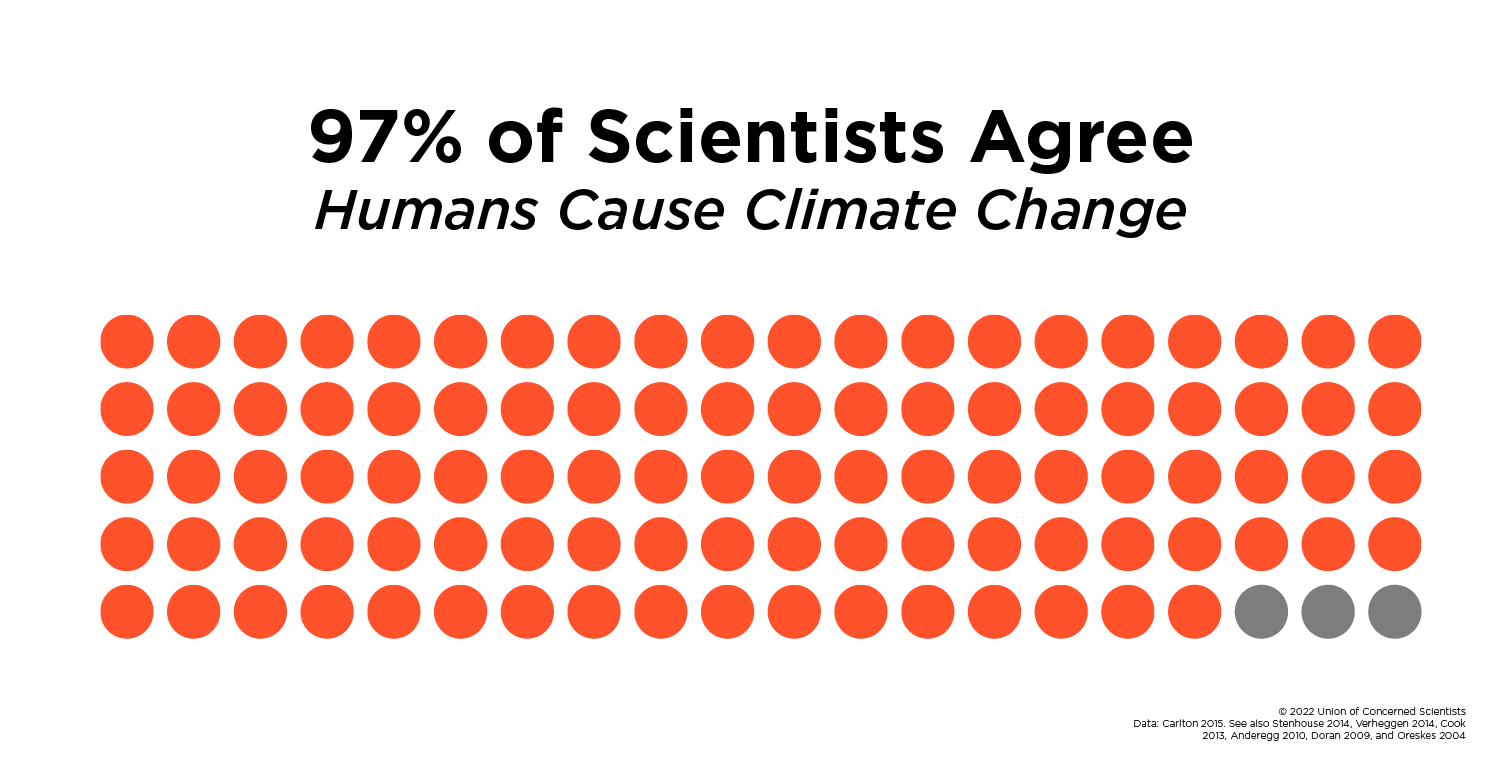
The scientific consensus
Within the scientific community, there is essentially no disagreement on the causes of climate change. Multiple studies have shown that at least 97 percent of scientists agree that global warming is happening and that human activity is the primary cause.
Major scientific assessments also agree. The 2018 US National Climate Assessment—whose authors include 300 leading scientists and thirteen federal government agencies—concludes that “it is extremely likely that human activities, especially emissions of greenhouse gases, are the dominant cause of the observed warming since the mid-20th century. For the warming over the last century, there is no convincing alternative explanation supported by the extent of the observational evidence.”
Similarly, an authoritative 2014 report by the Intergovernmental Panel on Climate Change, written and reviewed by hundreds of climate experts and scientists from countries around the world, states unambiguously: “Human influence on the climate system is clear, and recent anthropogenic emissions of green-house gases are the highest in history. […] Warming of the climate system is unequivocal, and since the 1950s, many of the observed changes are unprecedented over decades to millennia.”
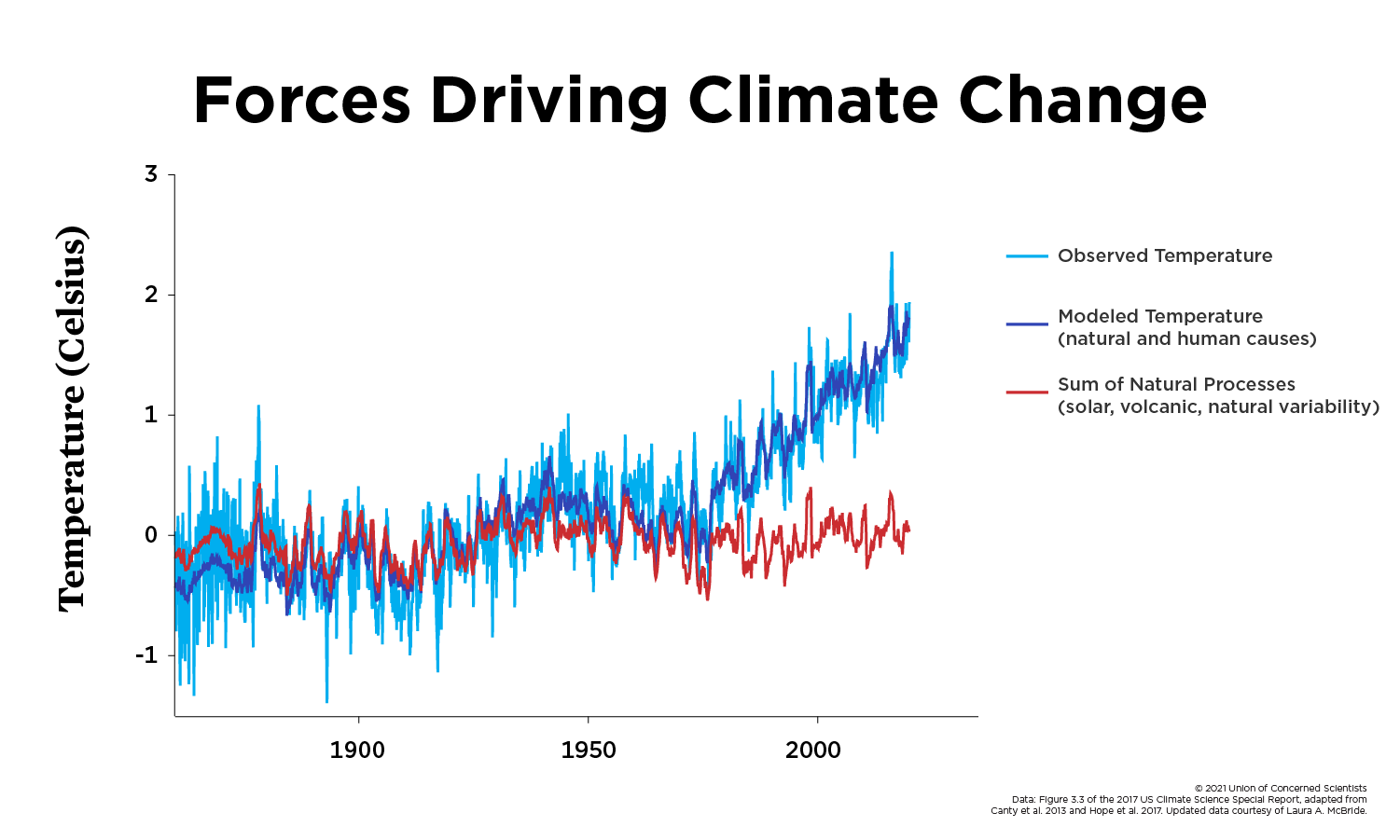
Natural factors
We know that warming and cooling have happened in the past, long before humans were around. Natural “climate drivers” include the energy from the sun; aerosols from periodic volcanic eruptions, dust, and salt spray; natural ecological phenomena like methane-emitting termite mounds and CO2 uptake by plants; and variations in snow and ice cover that change how much the Earth’s surface reflects the sun’s energy back into space (referred to as albedo).
All of these factors have profoundly shaped the Earth’s climate. However, none of them sufficiently explain the recent, dramatic increase in global temperatures. For that, scientists need to include human influences.
Natural drivers + human drivers best match reality
When natural and human-induced climate drivers are compared to one another, the human influences are so large that they crowd out other climate drivers over the past half century, producing the warming that we’re all experiencing. Put another way, when climate scientists focus only on natural climate drivers, their models cannot accurately reproduce the observed warming of the past half century. But when the models also include human-induced climate drivers, they accurately capture recent temperature increases in the atmosphere and in the oceans.
In fact, studies show that human activity is responsible for more than half of the warming observed since 1951.
This evidence has led organizations like the IPCC to conclude that the effects of heat-trapping gases and other human activities are both detectable throughout the climate system and “extremely likely to have been the dominant cause of the observed warming since the mid-20th century.”
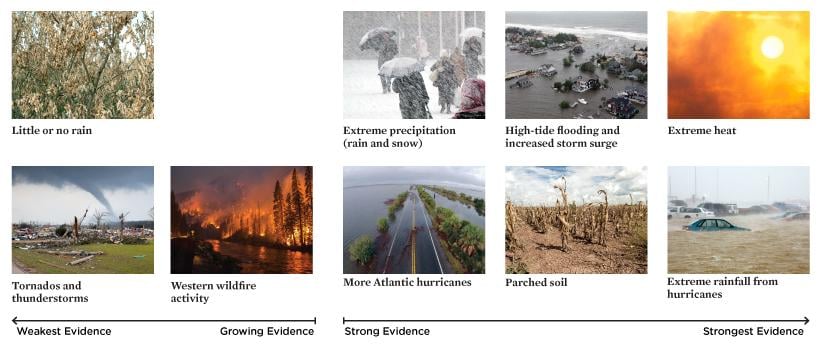
Are humans contributing to more extreme weather?
In recent years, the field of attribution science has become more sophisticated, and scientists are now able to quantify how much more likely an extreme event—such as a heat wave or a massive downpour—was as a result of human-caused climate change.
For example, in a landmark 2004 paper, researchers determined that climate change had at least doubled the risk of occurrence of the record-breaking 2003 European summer heat wave, which resulted in the deaths of tens of thousands of people. A 2016 study of the same heat wave concluded that human-caused climate change had increased the risk of heat-related mortality during the event by about 70 percent in central Paris and about 20 percent in London.
Similarly, researchers found that the record-breaking precipitation Texas experienced in 2017 during Hurricane Harvey was made three times more likely and 15 percent more intense by climate change.
More recently, scientists have found that fingerprinting of climate change can be detected in global daily weather patterns since 2012 and yearly patterns since 1999.
While some types of events are more readily attributable to global warming than others, attribution science is becoming increasingly robust. Several authoritative scientific institutions and government agencies have confirmed both the rigor and the validity of attributing individual extreme events to human-caused climate change.
We are the cause, and we are the solution
Knowing that human activities are the main driver of global warming helps us understand how and why our climate is changing, and it clearly defines the problem as one that is within our power to address.
We cannot avoid some level of warming caused by the heat-trapping gases already present in the atmosphere. Some of the gases (such as carbon dioxide and nitrous oxide) will last for more than a century. Many of the people who have contributed the least to global warming—including much of the Global South, and marginalized and low-income communities across the world—are facing the most severe impacts.
But with aggressive measures to reduce future emissions and adapt to those climate impacts we cannot avoid, we have a small window to avoid the worst climate change harms and build a better world.
What does that mean? It means investing in a clean energy economy and healthier and more livable and resilient communities. It means transforming transportation, reorienting our food system, and shifting to lower-carbon lifestyles. It means battling the disinformation spread by fossil fuel companies and other wealthy interests. And it means fighting for equity and environmental justice for all.
The Paris Agreement of 2015 called on nations to keep global warming under the dangerous threshold of 2°C, aiming for 1.5°C. In recent years, the global climate movement—and young people in particular—have been demanding we do even better. With the right policies, practices, vision and cooperation, acting boldly now will give us the best chance of creating the safe and promising future the youth of the world deserve.



